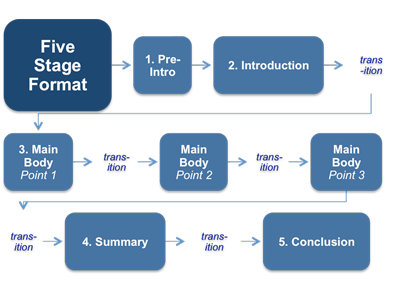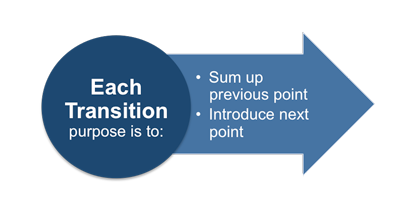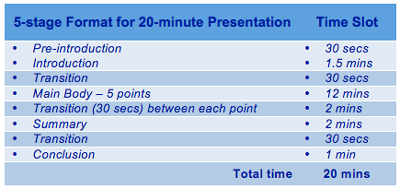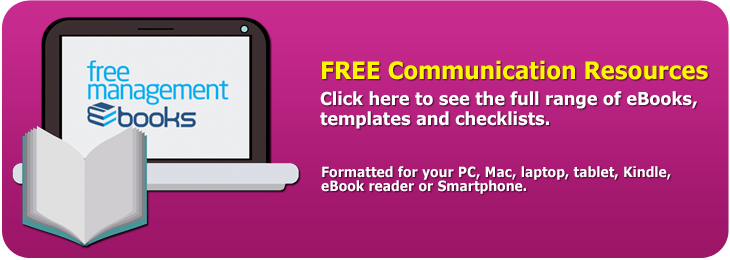Communication Skills - The Five-Stage Format
When you have the content in the form of a basic draft that you are happy with, you can then begin to turn it into a presentation. Most presentations should follow the five-stage format shown in the diagram below. This may look unnecessarily complicated at first sight, but it is actually very easy and natural to use in practice.
 |
One of the features of this method is the use of transitions between each of the stages and the main body key points as shown in the diagram above. The benefit of these is that they enable you to satisfy the needs of a mixed audience by allowing for different levels of knowledge. This enables you to focus on different groups at different points, yet retain the interest and attention of your whole audience.
This means that you start at a level of detail that orients everyone by serving as an introduction to the key point, showing its importance and relevance. For each key point of the main body you begin at a level where you're confident everyone will follow your meaning. Then go into more detail for that part of the audience that requires more depth, whilst accepting that some non-technical members of the audience may have difficulty following you.
However, you bring them back on board at the end of that topic by summarizing what you have just said in language you are confident that everyone will understand. Provided that you keep your introductions and summaries relatively close together and keep reminding the audience that you are going to summarize the detail you can generally keep the audience's attention even if some of them cannot always follow the detail of what you are saying.
 |
The first major transition occurs between the introduction of your presentation and the beginning of the content. Usually the main body will be broken down into several key points, each followed by a transition. Finally, there will be a transition between the end of the main body and the conclusion.
These transitions represent important points for the audience. The purpose of each transition is to sum up what has been said previously and to introduce the next key point or section. For example, when making the transition from the introduction to the beginning of the main body you should say something like:
'Now that I have explained what this presentation is about and why I am presenting this material to you I would like first of all to describe…'
When making the transition from one key point to another you could say something like:
'As I've just explained… (summarize). This brings us on to the next point (introduce)…'
All of these transitions are designed to orientate your audience and particularly to reengage with people whose attention has wandered off. Even those people you manage to lose during the detailed parts of your presentation should be able to follow the outline of it if you handle the transitions well.
For example, if you need to go into technical details about the IT infrastructure in order to support one of your key points, then you may lose audience members who are unfamiliar with that area of the business. However, you may not be able to avoid going into detail because you need to influence the people who do understand it. Your transition into this technical area could be something like:
'My second point concerns the inability of our IT infrastructure to support the number of customer calls we have at peak times. This is happening because…'
(Detailed Technical Explanation)
'… So, as I've just explained, we can't deal with the number of customer calls we're getting which is causing problems with customer retention. This brings me to my third point…'
Always remember that the audience does not have the luxury of being able to go back and re-listen to part of your presentation. It is quite easy for them to become lost if they are distracted or they start thinking in detail about something you have said.
No matter how well you structure your material, it is always possible for the audience to become disoriented. Bearing this in mind you should use the transitions to bring people back on board at regular points. For example:
If someone loses the thread part way through the second point your transition to point three should sum up point two to the extent that they can then follow you even if they had temporarily become lost.
For transitions to be effective they must be built in from the start. This means that you have to allocate a portion of time to each one. In a 20-minute presentation the timings could follow the pattern shown in the table below:
 |
Remember, these transitions are absolutely crucial because they will encourage most of the audience to stay engaged with you to the end. If you find yourself short of time then it is better to omit the detailed description of a key point (you can deal with it in the summary) than it is to omit the transitions between the key points you do present.
You may also be interested in:
Preparing a Management Presentation | Repetition and Timing | Your Presentation Aim | Preparing the Main Body | Key Point Guidelines | Finalizing the Main Body | Preparing Your Pre-Introduction | Preparing the Introduction | Preparing the Summary and Conclusion.



